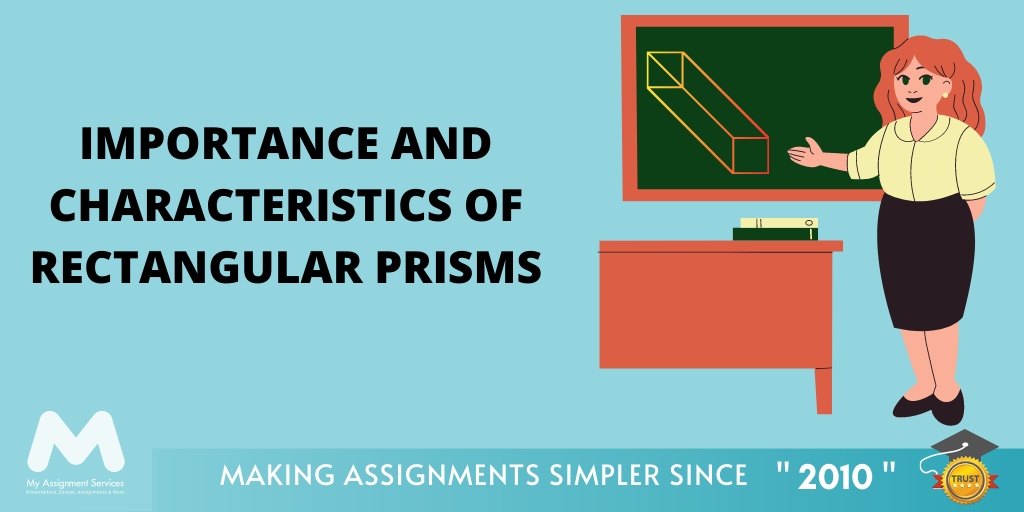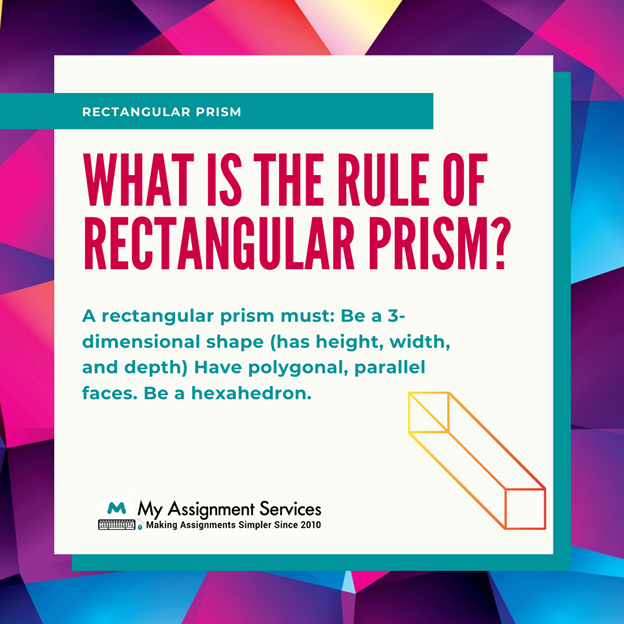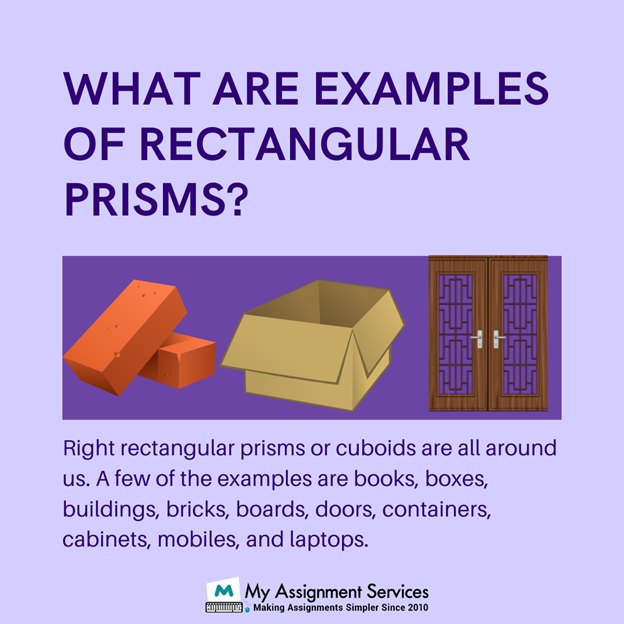
A rectangular prism is a geometric figure that has six faces, making it look like two rectangles on top of each other. The rectangle is often called the base. A prism is made up of three or more two-dimensional shapes with identical properties arranged in a line. All these shapes are called lateral faces. Another face, which is either square or triangular, comprises the base. This makes our prism into an open box or container with no ends to close off its contents from view. A regular hexagonal prism will have four triangles and two squares as its lateral faces, while an irregular hexagonal prism will have only triangles on its lateral faces.

Importance of Rectangular Prism
The rectangular prism has been in use since ancient times for measurement and even as a unit of time. It remains one of the most important standard units used for measuring volume, while its use as a unit of time was discontinued during the 19th century A.D (Anno Domini). The triangular prism is part of many standards that are used to measure things today, specifically when it comes to shipping containers. This is why you will see them all over ports and shipping areas like on ships or at train stations.
Can You Describe the Characteristics of a Rectangular Prism:
Dimensions:
You can create an infinite number of shapes if you modify some or all dimensions of your prism. The width of the top and the height and length of each lateral face can all be changed. You will also have an infinite number of options if you choose to modify the shape of your base from a square or triangle to something else altogether.
The triangular prism is defined by its height, which is always half the length of anyone's lateral face. If this height remains constant, then it will produce side lengths that are inversely proportional to each other. This means that if the height doubles, then either one or both sides must divide into two halves for this proportion to remain constant.
A hexagonal prism’s sixth lateral face is not necessarily required because these prisms are often cut off at some point when they are meant to be used for measurements.
Circumference:
The circumference is the perimeter of a closed curve and is typically measured in units such as centimetres or inches. The circumference of a rectangular prism will vary according to the length, width and height of anyone's lateral face - not on the specific dimensions that form your particular shape. To find this value, add up all four lateral faces' circumferences. If you have a regular hexagonal prism, it has six lateral faces, while an irregular hexagon has only five. This brings us back to our earlier statement regarding triangular prisms, which state that their sixth lateral face cannot be counted when calculating theirs. You can use a set of dividers or a ruler to measure circumferences.
Usage:
Rectangular prisms are used in almost all areas of engineering and construction as well as at home. They can be put to good use as storage units for food, clothes and other material if your house has limited storage space. You can also modify them into chairs, tables, surfaces that hold equipment such as speakers or even secure them onto doorways to hang coats on when guests arrive. Rectangular prism origami is just one example of the creative ways these shapes can help transform an object from within and outside by using different angles and folds. Finally, we take pride in the fact that rectangular prisms were invented during ancient times for commercial purposes, making our history all the more enjoyable.
Volume:
The volume of a rectangular prism is rather simple to calculate. It will depend on the area of each lateral face multiplied together. This can be simplified even further if you have a regular hexagonal prism because its six faces will share the same length, width and height values for this calculation - one set out of multiple sets that will provide an identical result. You can then just multiply three numbers together instead of six for a relatively quick result that does not require any calculations with fractions or decimals. Even when it comes to irregular hexagonal prisms, there are some simplifications that you can make in order to produce results quickly.
The first simplification comes from the fact that they have five lateral faces instead of six. This means that there will only be two sets of calculations, which means half the number to multiply together in order to find a total volume. The second simplification is easier because you can divide your prism into thirds and use its dimensions for one-third of each lateral face's area rather than its entire surface area. You can then add up these three numbers among themselves after multiplying them with a simple formula known as 'area × height × width'. This is an easy way to save yourself time and effort when calculating the volume of a rectangular prism.

Suppose you are dealing with a hexagonal prism with six identical lateral faces. In that case, it will be easier still to find its volume because all three values for length, width and height can be divided by 2 - resulting in the same number remaining on each side of the equation. This means that if you multiply two values together instead of six, then this value could also be halved before adding up the results. That would mean that you’d only need to divide one number into itself instead of dividing all three numbers through multiplication which makes finding their total volume even simpler than ever before!
Rectangular Prism Examples
Example 1:
A rectangular prism with a height of 3 cm, a width of 4 cm and a length of 5 cm has a volume of 12cm³.
How To Find A Volume Of Rectangular Prism:
- Measure out the height, width and length of your prism.
- Multiply these three values together to find the total surface area (lateral faces) for each face (3 x 4 x 5).
- Add up all lateral face areas together to find their total area (12).
- Divide one lateral face area by 2 as they are equal on opposite sides (12 / 2 = 6)
- Subtract this value from the total surface area as it is now unnecessary (6 – 6 = 0).
- Multiply the numbers that remain by 2 to find their total volume ((3 x 4) x 2) = 12
Area of Rectangular Prism
The area of a rectangular prism is also quite simple to calculate. You can begin by finding the sum of all six lateral faces' areas. This is made much simpler when you have hexagonal prisms because one set will equal another in terms of their combined surface area - so long as they share the same dimensions.
Even if you are working with an irregular hexagonal prism, it will not be too difficult to replicate this process because you can divide your prism into thirds and use its dimensions for one-third of each lateral face's area rather than using its entire surface area (which means that there would only be two sets of calculations). Another option that works even if your hexagonal prism has five lateral faces instead of six is to multiply the values for width and length together, halve this number before adding up the results and then multiply it again by two. This would mean that you’d only need to divide one number into itself instead of dividing all three numbers through multiplication which makes finding their total area even simpler than ever before!
Note: Unlike finding the volume, if your prism has 5 lateral faces, you will not need to divide one number into itself to find its surface area. This is because each set of calculations would equal 1/4 of an entire face's area rather than dividing all 3 values through multiplication which means that there would only be two sets of calculations involved in this process. The formula for finding a surface area is A = L x W, where "A" represents the surface area, "L" equals the length and "W" represents the width.
Concluding Lines
We hope this blog makes it easier for you to solve your mathematical problems on your own. . The rectangular prism is part of many standards that are used to measure things today, specifically when it comes to shipping containers. There are numerous other shapes too, which involve different formulas and concepts. If you are already confused with them, fret not. Fill the form right now if you want our team of experts to assist you with rectangular prisms and other math shapes. With our engineering assignment help, you can achieve academic success. We assist you with every sort of query, no matter how complicated it is. Hurry up, book your session Now.
Related Study Materials
Our Experts can answer your Assignment questions instantly.
Ask Question0 Comment
Get It Done! Today
1,212,718Orders
4.9/5Rating
5,063Experts













Loved reading this Blog? Share your valuable thoughts in the comment section.
Add comment